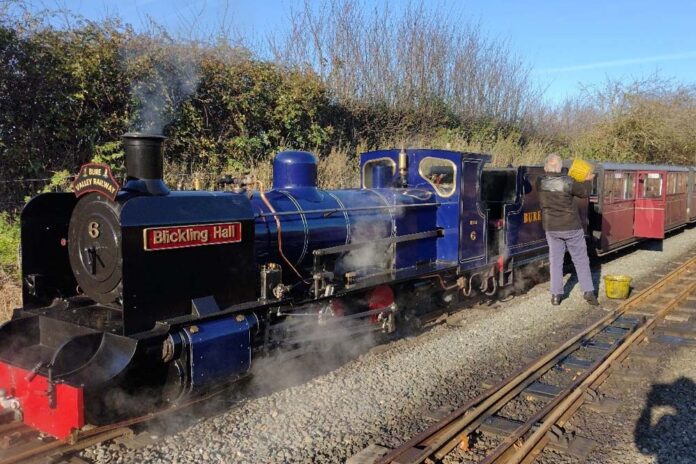Bure Valley Railway (BVR) has conducted further tests on bio-coal, putting it under more arduous conditions.
The Heritage Railway Association member had initially carried out some tests in June. These were conducted under normal Bure Valley operating conditions.
This second batch of tests was to see how the fuel fared under tougher working conditions and on a different engine. The team wanted to see how the bio-coal would work in different situations and on different locomotives.
HRA’s CEO Steve Oates said: “With the supply of coal now under threat and global prices escalating, there’s an increasing desire among members to know if any form of bio-coal will actually happen on a large scale.”
The trials were carried out in a collaboration between the Bure Valley, Advanced Steam Traction Trust (ASTT), and the fuel manufacturers Coal Products Limited (CPL) over two days – Tuesday 23 November and Wednesday 24 November. The morning departures to Wroxham burnt the Welsh coal from Ffos-y-fran as a base comparator, and the afternoon’s burnt a variant of Ecoal50 developed by CPL based on the feedback from the June trials.
The Tuesday trial used the previous test locomotive, No6 Bickling Hall, which is fitted with a Lempor exhaust; the Wednesday trial used No1 Wroxham Broad, which is fitted with a conventional exhaust. No6 had been used in the June trials.
The trials with No6 increased the load to 180% of the normal BVR load to really test the locomotive under the most arduous combustion conditions that are found on the mainline or Welsh narrow-gauge railways. No1 was loaded to 113 % of what it would normally haul.
The trials with No1 gave an opportunity to test the fuel on a different locomotive, which is smaller than No6 and also due for its 10-year overhaul in 2022.
Scott Bunting was the driver for these trials and the June trials. On both days, the railhead conditions were not ideal, with leaf contamination and, on the Wednesday with No1, the additional complication of light drizzle. Both locomotives were working at the limit of their adhesion even with the use of sanding and were a test of driver skill.
The test protocol was the same as in June, with the fuel in the tender weighed and the water consumption measured. The ash in the ash pan and the char in smoke box were also weighed. Transducers were rigged to a computer in the lead carriage to measure smoke box vacuum, which gives an indication of maximum combustion rate, exhaust performance, and speed.
ASTT produced the test protocol, provided the test equipment and supervised the trials and CPL attended the trials to see at first-hand how the fuels performed.
John Hind, chair of ASTT, said: “The June trials were only on one locomotive and at moderate firing rates and showed that No6 steamed as well with Ecoal50 as Ffos-y-fran but Ecoal50 fuel consumption was 28% greater than Ffos. To extend the knowledge base we were keen to trial the fuel at heavier loads with greater combustion rates and on another locomotive.
“The ’gut feel’ on the day from the footplate crew was that, with this variant of Ecoal50 the locomotives steamed adequately but not as well as with Ffos-y-fran. The initial thought is that this is because of unburnt fuel carryover especially at higher rates of working. We also saw clinker, on one run. There now comes a period of more detailed analysis and discussion with CPL.”
Julian Martin, sales director at CPL Industries said: “The two trials conducted at BVR clearly show that there is a great opportunity for manufactured smokeless fuels made using biomass materials to replace traditional coals used in steam engines. The latest trial provided some great learnings, and CPL’s R&D team look forward to continuing to work with the steam heritage sector to develop the ideal fuels. We’re extremely grateful for the support and feedback we’ve had from many within the sector and in particular the time the ASTT, BVR and HRA have given to this project. We look forward to trialling new ideas in the near future”.
HRA will be liaising with CPL Industries as its R&D team work to hone the company’s products to find a bio fuel that can imitate coal well enough to secure heritage steam for future generations.







































 0113 2082620
0113 2082620 info@railbusinessdaily.com
info@railbusinessdaily.com 15 Mariner Court, Wakefield WF4 3FL
15 Mariner Court, Wakefield WF4 3FL

